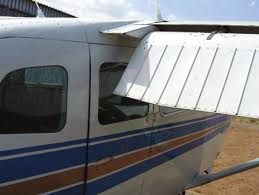The FAA is asking for input from pilots and operators of Cessna 206s as it mulls following Canada’s lead in issuing an airworthiness directive that would, among other things, limit seating to five instead of the normal six. Transport Canada has proposed an AD that would require all 206s on its registry to have an upgraded rear cargo door handle installed and placarded. It would also mandate the removal of one of the middle row seats to improve emergency egress from the plane, particularly in floatplane accidents.
The design issue at the root of the action has long been recognized. If the flaps are deployed 20 degrees or more, the double back doors won’t open fully. In an accident with the flaps down, rear row passengers have to clamber to the front row doors to get out. Canada’s Transportation Safety Board recently released a report on the capsizing of a 206 on floats in 2018 in which all the occupants survived the crash but three drowned. Only the pilot and the passenger in the front seats were able to get out. The TSB recommended Transport Canada issue an AD to make emergency egress of the aircraft better.
The issue has been discussed many times since it was first flagged in 1960s but agencies have previously determined there is no practical way to fix the conflict between the door and the flap. A redesigned door handle that allows the rear door to be forced open became available in the early 1990s and was used in aircraft built since 1998 but the majority of 206s were built before the new handle was designed. Canada is considering making installation of that $3,500 door mechanism mandatory along with removal of one of the middle row seats to clear the way to the front left door. The AD also requires that rear row passengers be briefed to use the front left door in an emergency and to only use the back doors if the front doors won’t open. Transport Canada is inviting comments on the proposed AD until March 18. The FAA is accepting input from U.S. operators as it investigates whether to follow the Canadian lead.




































For those who thought that Boeing’s MCAS was the epitome of stupid design….
The FAA approved this lunacy, too.
This is the same FAA that also approved Lycoming to install the wonderful dual mag (“D” mag) on thousands of engines, thus providing a single point of failure in a double backup system. Maybe we should start a blog entitled “Stupid FAA Tricks”.
Been a while since I flew one, so I wonder if installing a window that is openable like on a lot of Beechcraft airplanes would work. A lot of low wing airplanes have only one entry door so I wonder now if the FAA is going to review those designs as well. Being an old design I doubt Cessna even cares about this.
All of our vintage planes from the 50’s, 60’s and 70’s are not designed for crash survivability, much less egress after a crash. Best and cheapest solution is to carry a small ax. Done. No expensive AD required.
Well, since the 206 is still in active production, I’m pretty sure Cessna should care about the issue. Continuing to build a product with a known safety defect is a planitff’s lawyer’s dream. Sorry Mark, asking disoriented passengers to find an axe in an inverted and burning or sinking airplane is not likely to work.
I haven’t seen the revised door handle design, but perhaps changing the door hinge design so that a pull bar or similar mechanism would release the hinges and the door comes off completely.
John, put a placard on the rear cargo door and call it done. It’s a cargo door.
“…perhaps changing the door hinge design so that a pull bar or similar mechanism would release the hinges and the door comes off completely.”
That, and padding the fuselage-facing surfaces of the flap. It’s hard to figure out how this design ever got approved, much less proposed.